
India’s options market has been under the spotlight lately, with regulators stepping in to ensure greater market discipline and protect investors. In May 2025, SEBI introduced a new set of rules aimed at taming excessive speculative activity while strengthening risk monitoring in the equity derivatives space For traders—whether retail or institutional—this shift marks a new phase. Let’s unpack what’s changing, why it matters, and how you can adapt. 1. What Are SEBI’s New Rules? SEBI’s latest reforms introduced in May 2025 include: Enhanced real-time risk monitoring for large positions Strict expiry-day controls to manage elevated trading volumes Transparency mandates ensuring better mobility tracking across accounts These initiatives aim to reduce systemic risk, improve liquidity, and deter potential market manipulations. 2. Why It Matters for Options Trading Greater safety: Automatic checks help prevent rogue trades that destabilize markets Improved trust: With clearer oversight, more investors may feel confident entering derivatives Reduced volatility on expiry days: Tighter limits cut down sharp price swings Ultimately, healthier markets benefit everyone—from hedge funds to hands-on retail traders. 3. Impact on Retail Investors Less extreme volatility: Sudden spikes during expiry may now be less frequent Slightly higher margin requirements: Especially for large or concentrated positions Potential decline in retail trade volumes: Many cautious traders have already scaled back These changes favor informed trading over speculative bets, rewarding strategy, discipline, and awareness. 4. Adjusting Your Trading Strategy To stay ahead in a regulated environment: Focus on position sizing—avoid taking oversized bets that trigger risk alerts Use spreads or hedges to reduce margin costs and risk Plan for expiry-day behavior—volatility may be muted Stay compliant—track your exposures and maintain transparency in your delivery obligations By aligning with these rules, you can trade more confidently and sustainably. 5. Final Thoughts SEBI’s proactive steps are a milestone in institutionalizing robust risk management in options trading. While stricter, these changes help build a healthier market—where opportunity and discipline coexist. For traders, this means evolving from speculation to strategy, from position sizes to smart controls. In 2025, the goal isn’t just trading—but trading intelligently. 📌 Table of Contents What Are SEBI’s New Rules? Why It Matters for Options Trading Impact on Retail Investors Adjusting Your Trading Strategy Final Thoughts








